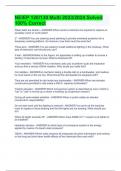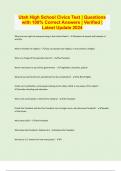Exam (elaborations)
ATI PEDIATRIC EXAM TEST BANK EVERYTHING ON ATI PEDIATRICS INCLUDING NCLEX 300+ QUESTIONS AND CORRECT ANSWERS(BEST DOCUMENT FOR ATI PEDS)AGRADE
- Course
- Institution
ATI PEDIATRIC EXAM TEST BANK EVERYTHING ON ATI PEDIATRICS INCLUDING NCLEX 300+ QUESTIONS AND CORRECT ANSWERS(BEST DOCUMENT FOR ATI PEDS)AGRADE
[Show more]





